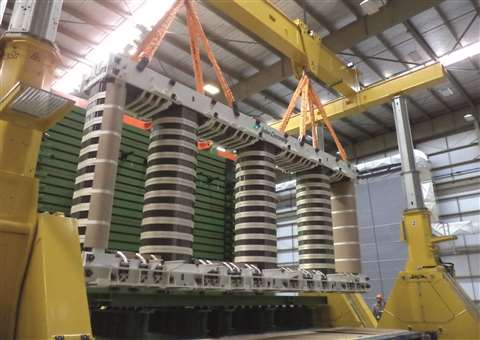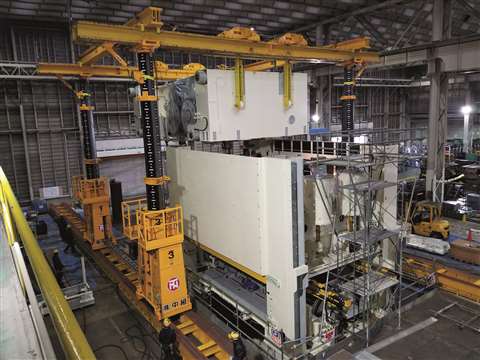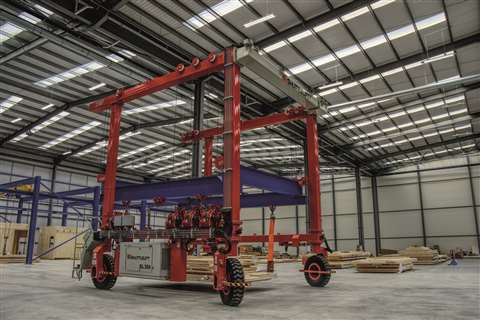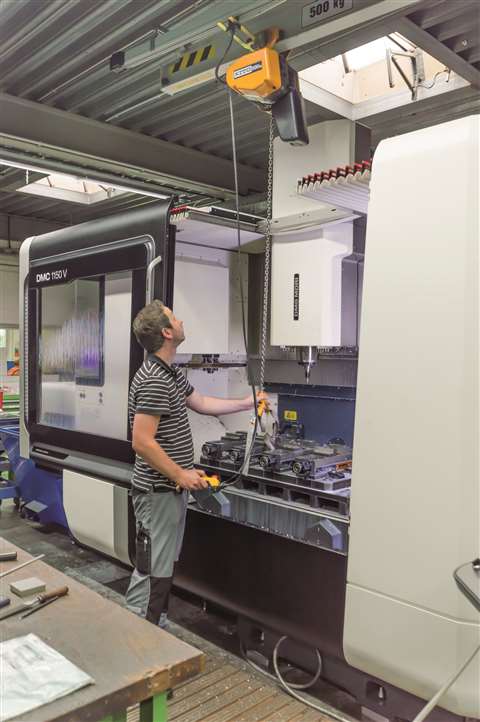Industrial Lifting: Smooth operators
13 March 2018
Industrial lifting covers a multitude of lifting and hoisting applications. Here we look at notable case studies and products on the market. CHRISTIAN SHELTON reports
Smooth operation is key to many industrial processes, whatever their scale. Fluidity aids work flow across all industries, although its importance is particularly evident in industrial manufacturing environments where production stages are inherently linked. Key to ensuring a smooth flow of work is having the correct equipment to carry out the required task. Here we look at a range of industrial lifting jobs and the equipment that was used to effect them.
Gantry systems
Heavy lift systems specialist Enerpac Heavy Lifting Technology (Enerpac) has been focusing on the lager end of the industrial lifting scale. “Recent Enerpac heavy lifting system developments have been aimed at expanding the industrial lifting options for contractors,” says Jeremy Stubbs, global product manager at Enerpac. “Faced with larger, heavier lifts where space is perhaps limited, and environmental and project conditions rule out traditional lifting systems, our gantry, jack-up and SPMT systems make projects possible.”
One such Enerpac project was for Tadeo Czerweny, an Argentina-based company operating in the electric power transformation market. The company wanted to expand its manufacturing capacity and build higher-capacity electric transformers. As part of this, it needed to vertically lift a heavy platform structure used to assemble electric transformer cores and transport large electric transformers within its plant. The maximum loads to be moved were 250 to 300 tonnes with a total height of 11 metres.

Tadeo Czerweny’s Enerpac hydraulic gantry has a lift capacity of 1,100 tonnes
To achieve this, Tadeo Czerweny used Enerpac’s SBL1100 hydraulic gantry series. According to Enerpac, its SBL1100 gantry can provide more accurate and controlled movements compared to using an overhead crane. The SBL1100 has a lift capacity of 1,100 tonnes with four towers and a lift height range from of 4.4 to 12 metres. Enerpac said these features were critical in the lifting process to successfully lift the platform structure that holds all the electric transformer cores to an upright position.
Enerpac says optimum stability and safety were provided thanks to the SBL1100’s self-contained hydraulics and electronics, self-propelled wheels (or tank rollers), and its Intellilift wireless control system – which provides the operator with information about the stroke, lift and load per unit and automatically corrects any unsynchronised motion of the individual units.
Marcelo Abreu, territory manager at Enerpac, comments, “Our SBL1100 gantry has automatic and synchronised systems that reduce the probability of human error during operation and allow operators to learn the system more efficiently.”
“The SBL1100 hydraulic gantry series was cost-effective for us since we could execute programmed heavy loads lifting and positioning in different points at our plant with a single piece of equipment,” adds Juan Pablo Zagayny, industrial engineering manager at Tadeo Czerweny.
According to Enerpac, staff at Tadeo Czerweny were provided hands-on training to ensure all operators of the gantry felt comfortable and confident before proceeding with the project.
In Japan, transport and logistics company Nakagumi has added to its gantry capabilities with a T1402-4-39 Lift-n-Lock hydraulic boom gantry from USA-based specialist manufacturer J&R Engineering (J&R). Its first stage capacity is 700 US tons (635 tonnes) with four lift housings. Its second stage capacity is 470 US tons (426 tonnes) to a lift height of 12.04 metres.
Nakagumi has used the gantry for the assembly of a new press in Japan. According to J&R, due to increased weights and lift heights of machinery in the automotive industry (mainly presses and power plant equipment such as generators, turbines, and transformers), Nakagumi purchased the T1402-4-39 to meet the demands of heavier equipment that needs to be placed or removed at higher elevations. As such, Nakagumi also bought the optional Lift Equalizer that allows synchronised lifting, lowering, and travel, along with Removable Work Platforms designed to help personnel perform their tasks safely.

Nakagumi’s T1402-4-39 Lift-n-Lock gantry from J&R Engineering has a first stage capacity of 700 US tons (635 tonnes)
In the UK housing association Swan Housing (Swan) has purchased an SL Series rubber-tyred gantry crane from US manufacturer Shuttlelift. The Shuttlelift SL 35II has a lifting capacity of 27 tonnes and the manufacturer says it will help Swan produce and move high-quality modular housing more cost-effectively.
The SL 35II will be used in Swan’s new factory which is dedicated to the offsite production of modular housing units. “It’s mobile and suits our requirements in design and movement,” explains Simon Ward, production manager of modular construction at Swan. “We wanted a flexible lifting approach for raw material delivery and finished products with large amounts of variation. The Shuttlelift gantry crane enables us to be flexible with our material handling rather than having multiple pieces of equipment to do individual functions.”

Swan Housing’s SL 35II rubber-tyred gantry crane from US manufacturer Shuttlelift has a lifting capacity of 27 tonnes
Hoists
In the hoist sector, Germany-based load pick-up and material flow specialist Kito Europe (Kito), part of Japanese chain hoist and chain technology company Kito Corporation, cites two examples where installation of its equipment has helped improve the flow of industrial production processes.
First, it provided a German steel foundry with a range of lifting equipment in order to make the maintenance of the production facilities as easy as possible. This included an LB lever hoist for heavy pulling, lifting, and clamping operations. According to Kito, the LB lever hoist has a fine-toothed precision gearbox and uses double reduction gearing and a patented induction hardening process on load bearing parts to reduce the weight and size of the hoist yet improving its strength compared to other products.
The steel foundry also bought a Kito CX mini hoist for lifting, pulling and positioning small loads, and a CF manual hoist which Kito says is specially designed with a closed aluminium die-cast construction for use in rough industrial environments.
According to Kito, the introduction of its equipment into the foundry, facilitated by German crane company Klein Seil-und Hebetechnik, has translated into significant time and cost savings, an increase in productivity, and a smaller work load. Kito says the foundry now only uses Kito hoists for all maintenance work.
Second, Kito Europe equipped German company SCS Werkzeug & Vorrichtungsbau (SCS) with a jib crane and an EQ electric chain hoist. SCS develops and supplies equipment for electronic manufacturing and other manufacturing processes.
According to Kito, SCS decided to install the crane and hoist in response to an increasing workload which had to be completed in a shorter time frame. It says since the introduction of its equipment, the production process is much smoother.
SCS uses two CNC machines as part of its production process. The column-mounted slewing crane and EQ electric chain hoist were installed above the two CNC machines, enabling heavy components to be fed quickly and precisely into them. “The electric chain hoist is an integral part of our organised operations,” comments one of SCS’s staff members in the production hall. “We can easily pick up the individual parts with the belt and position them exactly in front of the machine. This way the work never comes to a halt.”

SCS’s jib crane and an EQ electric chain hoist from Kito Europe facilitates smooth running of its production line
Kito explains that due to the large radius of the slewing crane, both machines are served by the chain hoist. The chain hoist has an electric overload inverter which Kito says helps with precise positioning of the load and provides the hoist with high running stability, thus increasing safety.
The EQ hoist is available in a range of lifting capacities from 125 kg up to 1,000 kg for a wide range of applications, says Kito Europe.
Rail-based projects
In the UK, specialist supplier of lifting, material handling and height safety products Lifting Equipment Store (LES) supplied 48 jib cranes, hoists and magnets to the ElecLink project. The project is designed to provide the UK with access to the international electricity market, enabling imports and exports of electricity. It is a wholly-owned subsidiary of Groupe Eurotunnel and the project involves transmitting electricity between Britain and France via the Channel tunnel.
Cranes, hoists and magnets provided by LES were used to lift and place supporting infrastructure for high voltage electricity cables running along the Channel Tunnel. The cranes were bespoke manufactured with unique features to enable them to be installed along a half-a-kilometre-long locomotive, says LES. They are designed for use in pairs and are controlled from a central control board instead of using standard pendant control, enabling the operator to stand at a safe distance from the load. The cranes were fitted with GPM electric chain hoists from Swiss manufacturer GIS and bespoke magnets from Eclipse Magnets.
The hoists were locked in to place on the arms of the jibs using a pin type locking device to avoid any unwanted movement during transport.
LES sales director Will Dunn says, “we spent over 12 months working closely alongside our customer to ensure every detail was taken care of. Prototypes were designed, built and tested to withstand travelling at the trains high speeds and the harsh British winter when stored outdoors.”
Another UK company, Sheffield-based engineering firm SCX – which specialises in lifting solutions and moving structures – worked with Westinghouse Platform Screen Doors (WPSD), a division of Knorr-Bremse UK Rail, in optimising the installation of their platform screen system on the Crossrail project in London. Crossrail is building ten stations on the new Elizabeth line, opening in 2018. Four kilometres of platform screen doors are required for the below-ground stations. Knorr-Bremse was awarded the contract to supply and fit the platform doors and SCX was commissioned to engineer a mechanism to automate the installation.
SCX’s solution is a mechanical modification to existing rolling stock. The screen door modules now arrive fully-built at the platform edge and SCX says its rig allows the screen door module to be positioned easily and precisely. Once the screen door module is fitted, the rig travels to its next position. Some platforms are obstructed by architectural gantries and columns. To overcome this, the rig features forward and backward tilting to manoeuvre under gantries, while horizontal movement allows the modules to be manoeuvred around the columns.
The rigs were used at Knorr-Bremse’s test site to train their engineers. Detailed platforms, including the PSD’s mounting plates, were recreated at the test site. Fully-built door modules were installed and tested before delivery. In the region of 500 door modules are to be installed, ranging from 5.5 to 6.3 metres in length, and 1.5 to 2.0 tonnes in weight.
So, from these examples, we can see the innovation that thrives in the industrial lifting sector; there really are lifting and hoisting solutions available for every industrial lifting application imaginable. Whether heavy industry, such as forging steel or installing electricity transformers, or more traditional industry sectors, such as house building and manufacturing electrical equipment, and even cutting-edge custom projects, such as installing platform screen doors and high voltage electricity cables in tunnels, the right lifting and hoisting solution can help any business become a smooth operator.






